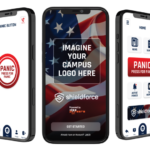The Red River flood that hit Moorhead, Minnesota last week was the highest measured flood in the city’s history. The flood spanned thousands of acres, knocked out power, and burned homes as rain, sleet and snow continued to fall on the city. Entire neighborhoods were lost. The damage could have been much worse if it were not for a relatively new technology called an emergency notification system.
Minnesota State University Moorhead used the new system, called e2Campus, to communicate life safety information to the community and to recruit volunteers for sandbagging efforts. And as 12 inches of new snow melts this week, MSUM and the city are preparing for a 500-year flood to crest next week around April 14th.
Michael Parks is the Security Director at MSUM and coordinated efforts to prepare the 7,500-student campus from the flood, “We used e2Campus to inform the campus community about the projected flood by way of text messages, phone calls, email, and web page postings. We initially closed the residential halls and campus.”
“Every few hours, the flood projections got worse, so we sent more alerts warning of life safety issues while also asking for volunteers to help keep up with the rising waters. About 20 minutes after an alert was sent, hundreds and hundreds of volunteers would show up to help with sand bagging. The local police department requested us to send more alerts as they witnessed the surge of volunteers after every alert. People that weren’t even signed up for the alerts were often times sitting next to someone that got an alert and were recruited to help. So for every person that got an alert, maybe 5 to 10 of their friends would come along with them.
“We know that e2Campus was the quickest, fastest way to get emergency life safety information to our campus community because we saw the overwhelming response after each alert. We could get fresh, timely information out to everyone as the conditions changed… and conditions were changing rapidly.
“As reports of the flooding got worse, hundreds of students and employees began registering for e2Campus who had not been included in the previous alerts. Everyone now understands why we have been talking about registering for over a year.
“Many of the multimodal alerts were sent during non-business hours. The text message alerts were effective in reaching the students spread around the city. For faculty and staff who did not have cell phones or power in their homes, the mass phone calls were their only source of life saving information.
“There is a lot of utility in how we used e2Campus this last week. During this time, went sent over 15 messages. More than 20,000 volunteers filled and stacked over one million sandbags. We estimate that at least two-thirds of the city was spared from the flooding as a direct result of the student’s sandbagging efforts.
“We evaluated several different notification systems and we were the first state institution in Minnesota to choose e2Campus. We took the educated risk to go with e2Campus and we certainly weren’t disappointed with the value and impressive functionality we got. The support and experience that we’ve had with e2Campus has exceeded our expectations and not only saved our community but also potentially saved lives and property damage.
Mr. Parks concluded, “The University is a safe haven in the community because of our location on high ground, so we anticipate using e2Campus next week to communicate accurate and timely information to the entire campus population and surrounding community.”
For additional information, click here.
Omnilert April 2009 press release.












